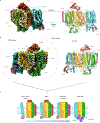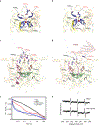Structural insights into photosystem II assembly
- PMID: 33846594
- PMCID: PMC8094115
- DOI: 10.1038/s41477-021-00895-0
Structural insights into photosystem II assembly
Abstract
Biogenesis of photosystem II (PSII), nature's water-splitting catalyst, is assisted by auxiliary proteins that form transient complexes with PSII components to facilitate stepwise assembly events. Using cryo-electron microscopy, we solved the structure of such a PSII assembly intermediate from Thermosynechococcus elongatus at 2.94 Å resolution. It contains three assembly factors (Psb27, Psb28 and Psb34) and provides detailed insights into their molecular function. Binding of Psb28 induces large conformational changes at the PSII acceptor side, which distort the binding pocket of the mobile quinone (QB) and replace the bicarbonate ligand of non-haem iron with glutamate, a structural motif found in reaction centres of non-oxygenic photosynthetic bacteria. These results reveal mechanisms that protect PSII from damage during biogenesis until water splitting is activated. Our structure further demonstrates how the PSII active site is prepared for the incorporation of the Mn4CaO5 cluster, which performs the unique water-splitting reaction.
Conflict of interest statement
Competing interests
The authors declare no competing interests.
Figures







References
-
- Hohmann-Marriott MF & Blankenship RE Evolution of photosynthesis. Annu. Rev. Plant Biol 62, 515–548 (2011). - PubMed
-
- Sanchez-Baracaldo P & Cardona T On the origin of oxygenic photosynthesis and cyanobacteria. New Phytol 225, 1440–1446 (2020). - PubMed
-
- Vinyard DJ, Ananyev GM & Dismukes GC Photosystem II: the reaction center of oxygenic photosynthesis. Annu. Rev. Biochem 82, 577–606 (2013). - PubMed
-
- Cox N, Pantazis DA & Lubitz W Current understanding of the mechanism of water oxidation in photosystem II and its relation to XFEL data. Annu. Rev. Biochem 89, 795–820 (2020). - PubMed
MeSH terms
Substances
Supplementary concepts
Grants and funding
LinkOut - more resources
Full Text Sources
Other Literature Sources

